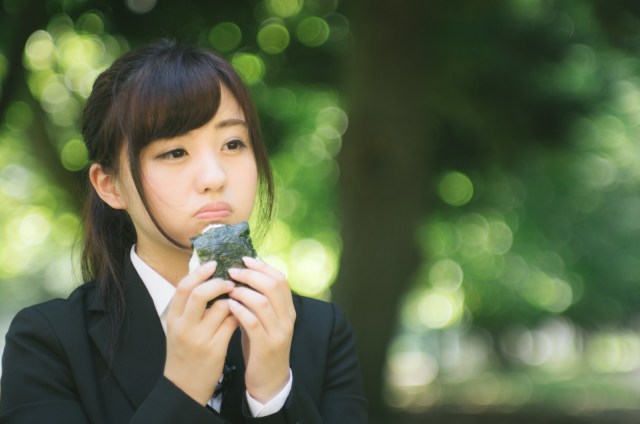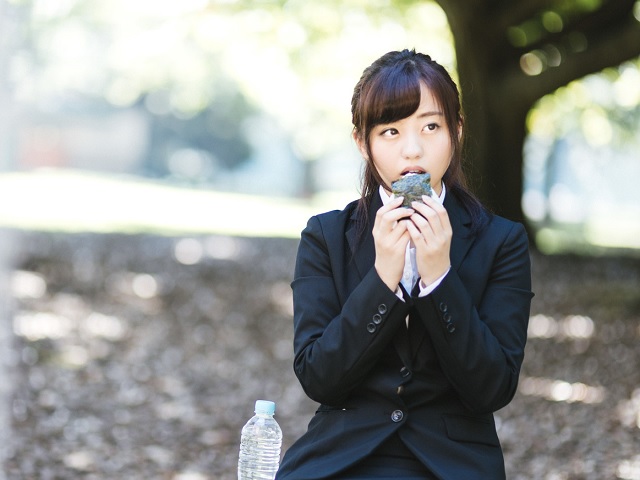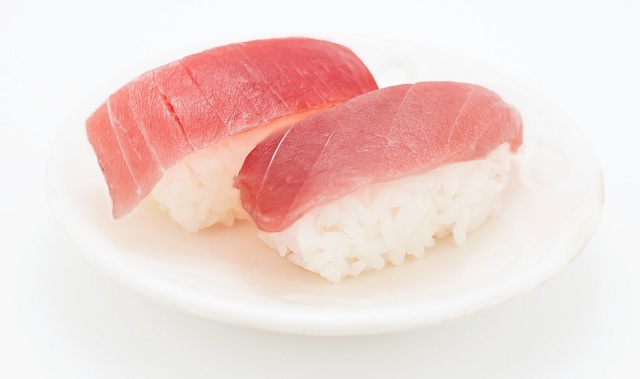
We call them “rice balls” in English, but the real-meaning of “onigiri” is something a lot of Japanese people don’t find appetizing.
In English, we usually call the food known as onigiri in Japanese “rice balls.” But should you have the pleasure of becoming gastronomically acquainted with onigiri, you’ll quickly discover that most of them aren’t ball-shaped. For example, triangular onigiri, like these ones, are extremely common in stores.
Even when onigiri are rounded, they’re more like thick discs than truly spherical balls.
That’s because the word onigiri doesn’t actually mean “rice ball.” It comes from the word nigiru, meaning to squeeze or press, and refers to the traditional way you make onigiri, by pressing the grains of rice together with your hands, with whatever filling you’re using placed at the center or the topping put on top after the onigiri has been formed. Linguistically, onigiri can be whatever shape you want them to be.
But remember how we said pressing the rice by hand is the traditional way to make onigiri? That’s because in the modern era of mass-produced onigiri, they’re often made by machine, and as machine-made onigiri become more and more common, part of the Japanese population has gotten squeamish about eating the pressed-by-hand variety.
Japanese variety program Abema Prime recently conducted a survey asking “Can you eat onigiri that someone else made by hand?”, and of the 50,000 respondents, only 46 percent said they were comfortable consuming bare hand-pressed onigiri.
An additional 42 percent said they were OK eating hand-pressed onigiri on the condition that a layer of plastic wrap had been placed between the rice and the maker’s hands. 10 percent, though said that even that isn’t good enough, and that they’re unwilling to eat hand-pressed onigiri entirely.
▼ The final two percent responded with “other,” but it’s unclear exactly what that means.
So why the strongly negative reaction to bare hand-made onigiri? A few theories spring quickly to mind. Probably the biggest hurdle is that onigiri is pressed after all the ingredients have been cooked. It’s one thing if a chef picks up a piece of meat with an ungloved hand and tosses it into a frying pan before it’s cooked and plated with a spatula. There’s no more heat being applied to that onigiri after it’s formed, though, so effectively someone is grabbing and squeezing your food, then giving it to you to pop into your mouth.
The increasing availability of onigiri at convenience stores is probably another contributing factor. Convenience store onigiri have become the majority of the onigiri many people eat, and since they’re machine-pressed, the concept of eating hand-pressed onigiri, let alone bare hand-pressed onigiri, is becoming increasingly removed from many people’s daily lives.
Along with machine-pressed chain store-bought onigiri becoming so prevalent, another factor to consider is that onigiri aren’t particularly common on restaurant menus. That leaves small, independent takeout shops and home kitchens as the two places you’re most likely to encounter pressed-by-hand onigiri, and in the case of home kitchens, you get into the question of how clean other people keep their homes and non-professional food handler hands, and the answer might not be as clean as you’d like.
Interestingly, pressed-by-hand nigiri sushi (which comes from the same nigiru as onigiri), the most common kind of sushi in which the fish or other topping is placed on a block of rice, doesn’t seem to trigger the same sort of negative reaction. Just like with onigiri, the rice in mass-produced nigiri sushi, such as at inexpensive revolving sushi restaurants or shops, is machine pressed, but at more expensive restaurants the rice is pressed by hand, with plastic wrap or gloves rarely used. Maybe the greater acceptance of bare hand-pressed nigiri sushi has something to do with the high-class image of sushi and sushi chefs.
In any case, though, it’s probably best to keep your reaction expectations modest if you offer someone an onigiri while telling them “I made it myself!”
Source: Sponichi Annex via Yahoo! Japan News via Otakomu
Top image: Pakutaso
Insert images: SoraNews24, Pakutaso (1, 2)
● Want to hear about SoraNews24’s latest articles as soon as they’re published? Follow us on Facebook and Twitter!





 Is it gross to eat sushi that the chef pressed with his bare hands?【Survey】
Is it gross to eat sushi that the chef pressed with his bare hands?【Survey】 Onigiri without the nigiri – Japan’s traditional rice balls get an update
Onigiri without the nigiri – Japan’s traditional rice balls get an update Is anime making otaku eat less rice? Government launches Girl Running Late with Rice Ball Project
Is anime making otaku eat less rice? Government launches Girl Running Late with Rice Ball Project Japanese convenience store’s newest rice ball filling: Nothing at all, and why we’re OK with that
Japanese convenience store’s newest rice ball filling: Nothing at all, and why we’re OK with that The 10 best types of onigiri rice balls to try in Japan【Survey】
The 10 best types of onigiri rice balls to try in Japan【Survey】 We revisited Sweets Paradise after a decade to see if Japan’s dessert buffet still delivers
We revisited Sweets Paradise after a decade to see if Japan’s dessert buffet still delivers Harajuku’s new permanent Tamagotchi shop is filled with cuteness and a surprising lack of poop
Harajuku’s new permanent Tamagotchi shop is filled with cuteness and a surprising lack of poop Japan’s two-month Shut-in Pilgrimage – A 1,200-year-old way to deal with a modern issue
Japan’s two-month Shut-in Pilgrimage – A 1,200-year-old way to deal with a modern issue Japanese thug wear from Birth Japan perfect for those breaking bad next year
Japanese thug wear from Birth Japan perfect for those breaking bad next year Japan has an awesome one-person bento box rice cooker, and here’s what we made with ours
Japan has an awesome one-person bento box rice cooker, and here’s what we made with ours Tokyo all-you-can-eat tonkatsu pork cutlet restaurant is all we need for a happy meal
Tokyo all-you-can-eat tonkatsu pork cutlet restaurant is all we need for a happy meal You can now buy a Japanese train station clock in Japan
You can now buy a Japanese train station clock in Japan Japan Misunderstood: 3 stereotypes that live on
Japan Misunderstood: 3 stereotypes that live on Is the new Shinkansen Train Desk ticket worth it?
Is the new Shinkansen Train Desk ticket worth it? Princesses, fruits, and blacksmiths: Study reveals the 30 most unusual family names in Japan
Princesses, fruits, and blacksmiths: Study reveals the 30 most unusual family names in Japan Starbucks Japan ready to get Year of the Horse started with adorable drinkware and plushies【Pics】
Starbucks Japan ready to get Year of the Horse started with adorable drinkware and plushies【Pics】 7-Eleven Japan’s ramen-cooking robot whipped us up a bowl of noodles【Taste test】
7-Eleven Japan’s ramen-cooking robot whipped us up a bowl of noodles【Taste test】 Cyberpunk anime meets traditional culture in Ghost in the Shell gold leaf Japanese changing screens
Cyberpunk anime meets traditional culture in Ghost in the Shell gold leaf Japanese changing screens 7 great places to see Mt. Fuji from without having to climb it
7 great places to see Mt. Fuji from without having to climb it Hello Kitty Choco Egg figures are an adorable trip through three periods of Japanese pop culture【Pics】
Hello Kitty Choco Egg figures are an adorable trip through three periods of Japanese pop culture【Pics】 Japan’s otoshidama tradition of giving kids money at New Year’s gets a social welfare upgrade
Japan’s otoshidama tradition of giving kids money at New Year’s gets a social welfare upgrade We found possibly the quietest Japanese-style hotel in Tokyo’s bustling Shinjuku district
We found possibly the quietest Japanese-style hotel in Tokyo’s bustling Shinjuku district Lacquerware supplier to emperor of Japan and Pokémon team up for new tableware
Lacquerware supplier to emperor of Japan and Pokémon team up for new tableware Sumo Sanrio! Hello Kitty and pals team up with Japan Sumo Association for new merch【Pics】
Sumo Sanrio! Hello Kitty and pals team up with Japan Sumo Association for new merch【Pics】 Can a dirty butthole make you filthy rich in Japan? We’re starting a New Year’s lottery experiment
Can a dirty butthole make you filthy rich in Japan? We’re starting a New Year’s lottery experiment 7-Eleven Japan starts new temporary luggage storage service in over 300 branches
7-Eleven Japan starts new temporary luggage storage service in over 300 branches Disillusionment at Tsukiji’s tourist-target prices led us to a great ramen restaurant in Tokyo
Disillusionment at Tsukiji’s tourist-target prices led us to a great ramen restaurant in Tokyo Starbucks teams up with 166-year-old Kyoto doll maker for Year of the Horse decorations【Photos】
Starbucks teams up with 166-year-old Kyoto doll maker for Year of the Horse decorations【Photos】 Tokyo considering law requiring more trash cans following litter increase in heavily touristed area
Tokyo considering law requiring more trash cans following litter increase in heavily touristed area Tokyo’s Tsukiji sushi neighborhood asks tour groups to stay away for the rest of the month
Tokyo’s Tsukiji sushi neighborhood asks tour groups to stay away for the rest of the month Nintendo’s Kirby now delivering orders at Kura Sushi restaurants, but not in Japan
Nintendo’s Kirby now delivering orders at Kura Sushi restaurants, but not in Japan Tokyo event lets you travel back in time, for free, to celebrate 100 years since Showa era start
Tokyo event lets you travel back in time, for free, to celebrate 100 years since Showa era start Sanrio theme park in Japan announces plans to expand into a Sanrio resort
Sanrio theme park in Japan announces plans to expand into a Sanrio resort Japan may add Japanese language proficiency, lifestyle classes to permanent foreign resident requirements
Japan may add Japanese language proficiency, lifestyle classes to permanent foreign resident requirements Survey asks foreign tourists what bothered them in Japan, more than half gave same answer
Survey asks foreign tourists what bothered them in Japan, more than half gave same answer Japan’s human washing machines will go on sale to general public, demos to be held in Tokyo
Japan’s human washing machines will go on sale to general public, demos to be held in Tokyo Japan’s deadliest food claims more victims, but why do people keep eating it for New Year’s?
Japan’s deadliest food claims more victims, but why do people keep eating it for New Year’s? We deeply regret going into this tunnel on our walk in the mountains of Japan
We deeply regret going into this tunnel on our walk in the mountains of Japan Studio Ghibli releases Kodama forest spirits from Princess Mononoke to light up your home
Studio Ghibli releases Kodama forest spirits from Princess Mononoke to light up your home Major Japanese hotel chain says reservations via overseas booking sites may not be valid
Major Japanese hotel chain says reservations via overseas booking sites may not be valid Put sesame oil in your coffee? Japanese maker says it’s the best way to start your day【Taste test】
Put sesame oil in your coffee? Japanese maker says it’s the best way to start your day【Taste test】 No more using real katana for tourism activities, Japan’s National Police Agency says
No more using real katana for tourism activities, Japan’s National Police Agency says Starbucks Japan reveals new sakura drinkware collection, inspired by evening cherry blossoms
Starbucks Japan reveals new sakura drinkware collection, inspired by evening cherry blossoms Updated cherry blossom forecast shows extra-long sakura season for Japan this year
Updated cherry blossom forecast shows extra-long sakura season for Japan this year Beyond rice balls: How to make an edible onigiri rice cat【Video】
Beyond rice balls: How to make an edible onigiri rice cat【Video】 The surprising semi-secret ingredient in many Japanese convenience store rice balls: oil
The surprising semi-secret ingredient in many Japanese convenience store rice balls: oil Rice balls that can last for 100 days at room temperature? Kyoto company makes high-protein onigiri
Rice balls that can last for 100 days at room temperature? Kyoto company makes high-protein onigiri Awesome rice ball making machine promises perfectly pressed onigiri in just 30 seconds【Video】
Awesome rice ball making machine promises perfectly pressed onigiri in just 30 seconds【Video】 Survey ranks convenience store rice balls – salmon, sea-dwelling poultry & plants steal the show
Survey ranks convenience store rice balls – salmon, sea-dwelling poultry & plants steal the show Onikun: Epic onigiri so big they’re half demon, half rice ball
Onikun: Epic onigiri so big they’re half demon, half rice ball Japanese convenience store issues rice ball recall, foodies would’ve loved to eat them anyway
Japanese convenience store issues rice ball recall, foodies would’ve loved to eat them anyway Say hello to the Big Bomb Onigiri, a beast of a Japanese rice ball
Say hello to the Big Bomb Onigiri, a beast of a Japanese rice ball The difference between onigiri rice balls in Tokyo and Osaka
The difference between onigiri rice balls in Tokyo and Osaka It’s a Japanese boxed lunch in the palm of your hand with the new bento rice ball
It’s a Japanese boxed lunch in the palm of your hand with the new bento rice ball What are Japan’s best, and most unique, regional rice balls?
What are Japan’s best, and most unique, regional rice balls? The polite way to eat onigiri rice balls sparks debate online
The polite way to eat onigiri rice balls sparks debate online Top Japanese instant noodle maker steps up its rice ball game 【Taste test】
Top Japanese instant noodle maker steps up its rice ball game 【Taste test】 Are Family Mart’s new “exquisite” rice balls worth the high price tag?
Are Family Mart’s new “exquisite” rice balls worth the high price tag? The Big Bomb Onigiri Japanese rice ball helps us conquer mountain race but conquers us in the end
The Big Bomb Onigiri Japanese rice ball helps us conquer mountain race but conquers us in the end
Leave a Reply